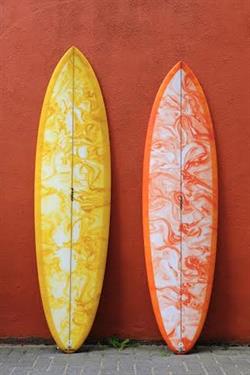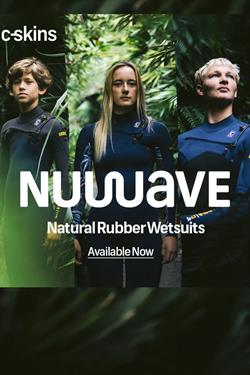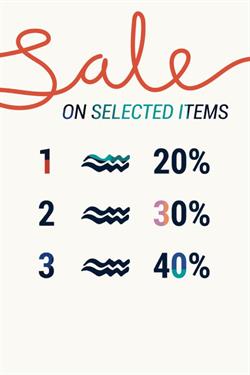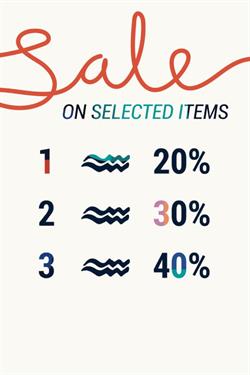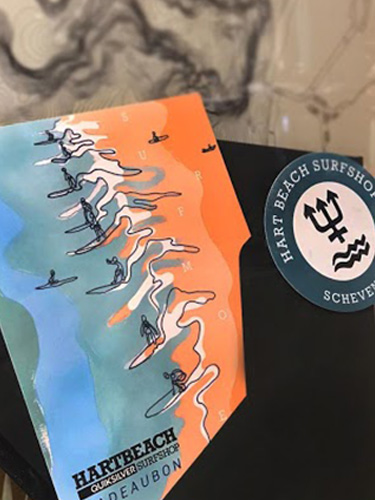Shop Wax
There is a certain amount of people that definitely undervalues a proper waxjob. And no, I'm not talking about the private parts of a lady here. I’m talking about getting that proper stick under your feet on your surfboard.
Some of us out there don’t really care. They Find an old, sandy wax nugget under the passenger's seat, slap some on their deck and toss it back on the dash, only to turn into that wax stain their mom is complaining about the week after.
Me personally? I like to keep the wax in the box, stashed into my “wax compartiment” in my car, next to my spare fins and comb. To me, wax matters.
I’ve had way too many sessions where I was just dancing around my board trying to find some proper grip, not daring to go for that power turn, because I knew I would slip out. To make sure this does not happen to you, we would like to talk to you about surfwax.
The origin of surfwax
Back in the day it was really hard to find your footing on the long, hand shaped wooden logs. People tried different kinds of things to fix this.
Al Gallant and Doc Ball began to give their wooden boards a thin layer of sand-infused varnish. This increased the traction a lot, but also scraped their knees, chest, feet, and thighs.
Later in 1935, Al applied a small amount of liquid floor wax to the deck of his surfboard, because his mother used it for the floors at home. Now out of floor wax, his angry mother proposed paraffin wax instead. He embraced the tip and went for it. He loved the result and the birth of surfwax was here.
Today, paraffin is still the main surf wax ingredient, along with beeswax, petroleum-based products, rubber or resin, and plastics for temperature control. Ingredients are mixed and heated to 130 degrees, then poured into metal molds.
Basecoat vs. Topcoat
The basecoat is the first layer of wax that you will apply to your surfboard. Generally, the basecoat will consist of a harder wax that can generally be used in warm water or tropical climates.
What’s the purpose of this coat? In short, the basecoat is meant to hold your topcoat down better and longer.
Topcoats are the more softer kind of wax that will give you more grip than the basecoat. You can also use topcoats without a basecoat, but then you will get bald spots more easily.
The importance of wax temperature
When choosing your wax, it’s very important to pick the right hardness. This all depends on the temperature of the water in which you are going to use the wax. The following table shows what wax to buy in what water temperatures.
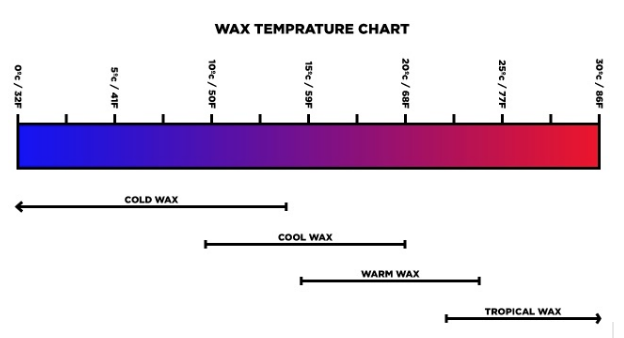
* This is a global chart! With each brand these temperatures vary, so check per brand.
So there’s a clear overlap in what wax to surf in different temperatures. Why you ask? Well, some people like to surf harder wax and some people softer wax.
Softer waxes will be
- Stickier
- Easier to apply
- More likely to move or rub away at pressure points on your board
Harder waxes will be
- Less sticky
- Somewhat more difficult to apply
- More likely to stay in place and not rub off
Keep in mind that every brand has its own formulas and puts them in different categories. So check what the water temperature is and choose your liking accordingly.
Different kinds of brands, what do I want?
Every person's perception of a great bar of wax is different.
The one one loves it a little slippery, the other wants his board glued to his feet.
Personally, I think that the ideal surfwax should feel soft, yet it shouldn’t smear easily.
I should be able to lift my foot of the wax and be able to alter my stance, but not slide it around.
This all sounds odd and contradictory, but that is exactly why it’s so hard to make a great bar of surfwax.
There are a few brands that have been around for a long time that have been on top of the market, such as Sex Wax and Sticky Bumps.
Over the last years, Brazilian brand Fu Wax has emerged on the scene by claiming the hearts of some of the worlds best tour surfers. They made the mainstream brands reevaluate their existing formulas and with that, new kinds of wax came to life.
If you just started buying surfwax, start out with the standard formula of each of the brands. from there, you can decide if you want your wax to be more sticky, or less sticky.
Always stay curious and try different brands to see what you like.
If you want something extremely sticky, you can use the more sticky variants of the brands. For example, Sex Wax has a ‘Dream Cream’ formula and Sticky Bumps has ‘Punt’ wax. These can be extremely sticky, so if you are still adjusting your feet a lot, maybe this is not for you.
There are also many brands that are looking to find more environmentally friendly alternatives. There are brands like Matunas who make eco surf wax for which they grow everything locally on their farm.
How to apply wax and where.
There are two big movements when it comes to waxing a surfboard: you’re either a circle guy, or a criss-cross guy. Waxing in a circular motion can be a bit more difficult to get started. However, I think waxing in small circles leads to more consistent bumps of wax. The criss-cross method is certainly the quickest way to go and that’s probably why most tour pros who go through dozens if not hundreds of boards each year use it. Either way, it’s more of an opinion or preference than a right or wrong way. So grab a comfy seat, put your board on your lap, and get ready to put in some elbow work.
We are going to put wax on the deck of your board from rail to rail on the areas where you’ll place your feet and where you’ll put your hands when you pop-up. For a longboard, this could mean the entire deck. For a shortboard, this could mean covering about two thirds of the board, because you won't be standing on the nose.
The goal is to create an even distribution of “bumps”.
Step 1: Apply the basecoat
The Circle Method
Hold your bar of wax so the thinner side is touching the board. Using “very light pressure,” begin to rub the wax in small circles — slowly moving along the deck of your board with each new circle. Remember, this is just a base coat; you don’t want much more than a thin layer of wax at this stage.
Continue to put wax in circles on the board until you’ve covered the part you want it to go. If you’ve got some pressure dings that aren’t filing with wax, use the corner of the bar like a pencil to get some wax where it needs to go.
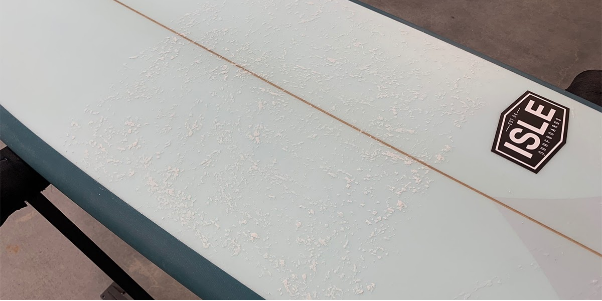 The Criss-Cross Method
The Criss-Cross Method
Hold your bar of wax so the thinner side is touching the board. Using “light pressure,” draw long diagonal lines across the deck of your board on the areas you’ll be standing and where you’ll put your hands when you pop-up.
Once your crosshatch is complete, fill in the squares with some “very light” circular motions. If you’ve got some pressure dings that aren’t getting filled, use the corner of the wax to apply it where it needs to go.
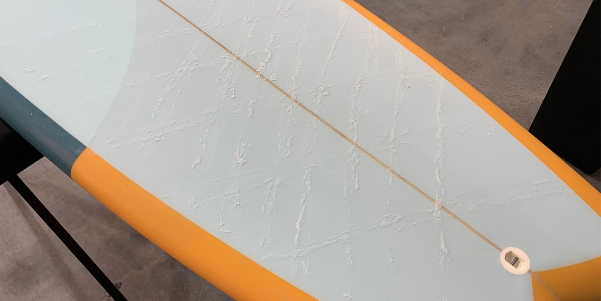 Step 2: Apply your topcoat
Step 2: Apply your topcoat
Regardless of the method you used to apply your base coat to the surface of your board, you’re going to want to apply your top coat of wax in small circles. The goal here is to create as many little bumps as possible, which is accomplished through light pressure and an even waxing motion. You’ll want to use about twice as much wax on the top coat as you did with the base coat. Once your board is good and covered, you’re good to go!
How and when to remove wax
The main reason to remove your wax is when you begin to feel that you are losing traction with your board. The more you surf, the less effective your wax will be.
Another could be that the seasons are changing or you are travelling. When your wax is soft and you are going to warm temperatures, everything will melt together, so it will be a good idea to get a fresh layer.
I gotta be honest and say that I once just did it because the wax looked very dirty and wanted a virgin like white layer on my new board.
So say goodbye to your current application and reapply.
There are several methods of removal.
Sun ‘n Sand
Some surfers find it easiest to just cover their boards with sand and leave them for a few minutes. The sand will interact with molecules in the wax and loosen the substance from your board. After a few minutes, simply come back to your board and wipe it over with the sand covering it. This should provide you with a top-notch clean.
Waxcomb
If you're still at home and it’s a hot day, put it in the sun with a rag underneath. When the wax is nice and soft, use the waxcomb (or an old creditcard) to swipe the wax off the board, on the rag. These combs are ideal to have in your car, because you can use the teeth of the comb to rough up your old wax job when you forgot to bring new wax.
Wax Pickle
Pickle Wax Remover is a unique tool used to remove the surf wax from any surfboard. It’s made out of recycled materials and is a rough bag that you use to wipe old wax remains off your board. You will first have to take off the thick old top layer with a wax comb though
Wax remover
You can also use wax removers to clean the last leftovers off your board. You will first have to take off the thick old top layer off with a wax comb. Then use the remover to swipe off any old residue. make sure to rinse your board properly afterwards.
It’s important that you get your board as clean as you can. Leftover residue from your previous application can interfere with your new job.
Extra wax tips
- Keep your wax out of the sun. Wax will melt and you will have to do it all over again or you can't get into the water. The wax bars in your car also melt.
- When taking a break on the beach, put your board somewhere with the wax down, out of the sun.
- Try and not get sand in your wax. especially when you are in warm climates and surfing in your boardshorts. Sand will give you rash, so save your thighs and nipples my friend.
- Don’t press too hard when applying wax. When applying wax to your board, it’s crucial that you apply the right pressure. Pressing too hard can lead to over-application.
- Try different types of wax. Every surfer has their favorite type of wax, and why not find your new favorite brand?
- Use the teeth a wax comb to rough up your old wax sometimes instead of applying new. Just run them down the old layer. Not too hard, just so you rough up the wax, not the board.
